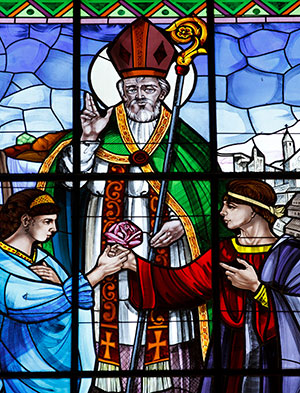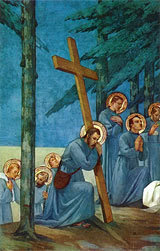 St. Valentine, officially known as St. Valentine of Rome, is a third-century Roman saint whose feast day on Feb. 14 is commonly associated with love and romance. Yet early Church history records that at least three St. Valentines existed in the second half of the third century – all of them martyrs, and all having the feast day Feb. 14.
St. Valentine, officially known as St. Valentine of Rome, is a third-century Roman saint whose feast day on Feb. 14 is commonly associated with love and romance. Yet early Church history records that at least three St. Valentines existed in the second half of the third century – all of them martyrs, and all having the feast day Feb. 14.
One is described as a priest at Rome, another as bishop of Interamna (modern Terni, Italy), and a third who suffered in Africa with a number of companions.
Although not much of his life is reliably known, it is highly agreed that someone named Valentine was martyred and then buried on the Via Flaminia to the north of Rome in or around the year 269.
Legends attributed to the mysterious saint are as inconsistent as the actual identification of the man.
One common story about St. Valentine is that in one point of his life, as the former Bishop of Terni, Narnia and Amelia, he was put under house arrest by a man named Judge Asterius. While discussing religion and faith with the judge, Valentine pledged the validity of Jesus. The judge immediately put Valentine and his faith to the test.
St. Valentine was presented with the judge’s blind daughter and told to restore her sight. If he succeeded, the judge vowed to do anything for Valentine. Placing his hands onto her eyes, Valentine restored the child’s vision.
Judge Asterius was humbled and obeyed Valentine’s requests. Asterius broke all the idols around his house, fasted for three days and became baptized, along with his family and entire 44 member household. The now faithful judge then freed all of his Christian inmates.
St. Valentine was later arrested again for trying to convert people to Christianity. He was sent to Rome under the emperor Claudius Gothicus (Claudius II).
According to what is believed to be the first representation of St. Valentine, the “Nuremberg Chronicle,” St. Valentine was a Roman priest martyred during Claudius’ reign. It recounts that St. Valentine was imprisoned for marrying Christian couples and aiding Christians being persecuted by Claudius in Rome. Both acts were considered serious crimes.
A relationship between the saint and emperor began to grow, until Valentine attempted to convince Claudius of Christianity. Claudius became enraged and sentenced Valentine to death, commanding him to renounce his faith or be beaten with clubs and beheaded.
St. Valentine refused to renounce his faith and Christianity, and he was executed outside the Flaminian Gate on Feb. 14, 269. (However, other tales of St. Valentine’s life claim he was executed in the year 270, 273 or 280.)
Other depictions of St. Valentine's arrests tell that he secretly married couples so husbands wouldn’t have to go to war. Another variation of the legend of St. Valentine says he refused to sacrifice to pagan gods and was put in prison, and while imprisoned he healed the jailer’s blind daughter. On the day of his execution, he left the girl a note signed, “Your Valentine.”
Pope Julius I is said to have built a church near Ponte Mole in his memory, which for a long time gave name to the gate Porta Valetini or Gate of St. Valentine. It is now called the Porta del Popolo.
Popular customs associated with St. Valentine’s Day may have had their origin in the Middle Ages. It was believed that on Feb. 14 – halfway through the second month of the year – birds begin to pair in preparation for spring mating season. Thus in Chaucer's “Parliament of Foules” we read:
“For this was sent on Seynt Valentyne's day
Whan every foul cometh ther to choose his mate.”
For this reason the day was looked upon as specially consecrated to lovers and as a proper occasion for writing love letters and sending lovers’ tokens.
Then again, according to English 18th-century antiquarians Alban Butler and Francis Douce, Valentine’s Day was most likely created to overpower the pagan holiday, Lupercalia.
Although the exact origin of today’s Valentine’s Day is not widely agreed upon, it is widely recognized as a day for love, devotion and romance.
And whoever he was, a St. Valentine did really exist, because archaeologists have unearthed a Roman catacomb and an ancient church near his burial site that was dedicated to his martyrdom.
Feb. 14 has been celebrated as St. Valentine’s Day since the year 496, when Pope Gelasius set aside the day in honor of his martyrdom.
St. Valentine is the patron saint of engaged couples, beekeepers, epilepsy, fainting, greetings, happy marriages, love, lovers, plague, travelers and young people. He is represented in pictures with birds and roses.
— CatholicOnline.com, Catholic Encyclopedia.
Pictured at top: The flower-crowned skull of St. Valentine can be found in the Basilica of Santa Maria in Cosmedin, Rome.
St. Valentine: How a beheaded martyr became the poster child for romantic love
In most stores in the weeks leading up to St. Valentine’s Day, you’re likely to find a plethora of pink and red cards, heart-shaped boxes of Russell Stover chocolates, and decor with nearly-naked chubby cherubs shooting hearts with bows and arrows.
It’s a far cry from the real St. Valentine, an early Christian martyr who was bludgeoned and beheaded for his faith.
It’s also a far cry from an early Roman fertility ritual also celebrated on Feb. 14, where men ran through the streets slapping women with the flesh of recently-sacrificed animals.
So how did a saint with such a gruesome death come to be associated with a holiday all about love, chocolates, and chubby cherubs?
 These seven men were born in Florence, Italy and led lives as hermits on Monte Senario. They had a special devotion to the Blessed Virgin Mary.
These seven men were born in Florence, Italy and led lives as hermits on Monte Senario. They had a special devotion to the Blessed Virgin Mary.
On Friday, April 13, 1240, the hermits received a vision of Our Lady. She held in her hand a black habit, and a nearby angel bore a scroll reading “Servants of Mary.”
Mary told them: “You will found a new order, and you will be my witnesses throughout the world. This is your name: Servants of Mary. This is your rule: that of Saint Augustine. And here is your distinctive sign: the black scapular, in memory of my sufferings.
They accepted the wisdom of Our Lady, wrote a Rule based on Saint Augustine and the Dominican Constitutions, adopted the black habit of an Augustinian monk, and lived as mendicant friars. The men founded the Order of Servites which in 1304 received the approval of the Holy See.
They are venerated on Feb. 17 because it is said to be the day on which St. Alexis Falconieri, one of the seven, died in 1310.
All seven were beatified Dec. 1, 1717, by Pope Clement XI and canonized in 1887 by Pope Leo XIII.
— Catholic News Agency
More online
At www.servite.org: Learn more about the Order of the Servites

